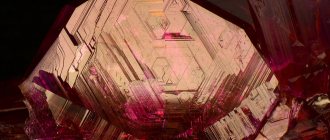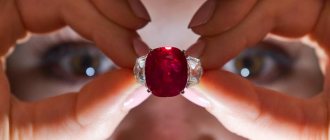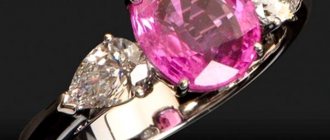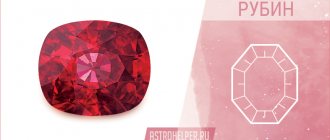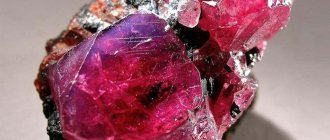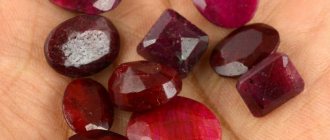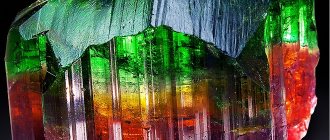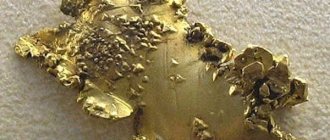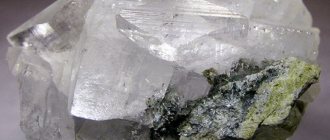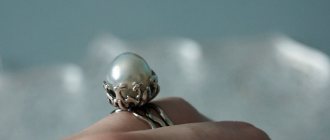What determines the value of a ruby?
Types of rubies
- Deposit and color of the stone. The most expensive rubies are “the color of pigeon blood”; they are scarlet and rich. Rubies with pink or purple hues will be cheaper. Burmese stones are most valued, stones from Mozambique are a little less valuable. Rubies from India, Vietnam and Thailand are considered cheaper. Only a specialist can determine the country of origin of a ruby.
- Purity of the stone. Cracks, foreign inclusions, and cloudiness negatively affect the price of the stone. But if a ruby contains natural inclusions of rutile, it will cost more. Small needles of rutile in certain lighting form a star-shaped effect.
- Mineral weight. Large rubies are practically never found in nature. Therefore, the price of a stone per carat will increase in proportion to its weight.
- The cut of a finished ruby affects the revelation of its radiance and natural brilliance; you can recognize an expensive stone by its quality cut.
- Natural or artificial origin of the stone. A lab-grown stone is much cheaper than a naturally occurring mineral.
- Exchange rates. The price of precious stones is published on the world market in dollars; with exchange rate fluctuations, the price of jewelry in Russia may rise or fall.
Where did this expression come from?
There is no exact data about this anymore. This expression was popular back in those distant times when Myanmar (Burma) was closely connected with the Chinese Qing Empire.
There is a legend that the bloodthirstiness of the locals knew no bounds, and the color of the ideal stone had to match the first drops of pigeon blood, because... pigeons were then a “delicacy”. I'm not convinced this is worth believing.
What is really beyond doubt is that this expression “has become popular” specifically for the best Burmese rubies (present-day Myanmar).
What does a pigeon's blood ruby look like?
These are rubies of rich red color with a slight bluish tint. The color of the stone is given by an admixture of chromium, which is responsible for the so-called “fluorescence” property of ruby.
Fluorescence - simply put: the ability of a stone to become “self-luminous” while it is illuminated by an external light source.
What does this mean?
Under artificial light, pigeon blood rubies begin to glow with a bright red hue, strong flashes appear, and it looks like the flickering of a hot coal.
This property is most pronounced in Burmese rubies of excellent quality. After all, the brighter the color and the fewer inclusions, the better the shine.
However, Burmese rubies over 3 carats are almost no longer found, and this gives the opportunity to develop the market for rubies in other countries. And large Burmese “pigeon blood” rubies immediately become a new lot in auctions.
Mozambican rubies
After 2010, Mozambican rubies entered the arena as a good alternative to Burmese rubies, which are very expensive and very scarce. But how good are they?
Externally, Mozambican rubies are darker; among them, samples with good clarity can also be found. But the most important factor that reduces their cost is a weak glow, i.e. fluorescence effect. Most likely, this is due to a different quantitative content of chromium impurities in the composition. In addition, unlike Burmese rubies, today there is already a glut of Mozambican rubies on the market.
Therefore, no matter what representatives of retail chains say about the “sameness” of Mozambican and Burmese rubies, there is still a difference, and a significant one.
Factors influencing the value of a ruby
1. Origin . Yes, not every Burmese ruby is a pigeon's blood ruby. But the hit rate is high.
Let me give you an example: at all Christie’s and Sotheby’s auctions, it is Burmese rubies that are valued from hundreds of thousands to a million dollars per carat. Among them, there was not a single Mozambican sample.
2. Color. After the mining region, this is the most important factor. Even if there are visible inclusions in the center of the ruby, the stone will be highly rated if it is richly red in color with a bluish tint. Paler and pink specimens are not highly rated.
3. Inclusions. The first rule of a gemologist is: “Beware of rubies that have no inclusions and are completely transparent.” Most likely it is synthetic.
Inclusions are not the main pricing factor. But if the number of inclusions covers the central part of the stone (when viewed through the platform), then the sparkle of the stone is poorly visible (this affects fluorescence). Then it is low purity.
In the Russian Federation, rubies are assessed by color and purity in accordance with the 2001 Specifications. There are 3 color groups and 3 quality groups. Most likely, when looking at the tag on a piece of ruby jewelry, there will be characteristics listed, for example: 2/3, 3/3, or 2/2. The first number is color, the second is purity (the presence of inclusions in the stone).
4. Ennoblement. If a ruby is of a unique size, then it is not refined in order to sell it for millions. In other cases, as a rule, they are heated to improve the color-purity characteristics by 1 order of magnitude.
Since 2005, the price of rubies has only increased. And it’s clear why - alternative natural stones with the same rarity in nature, “pigeon’s blood” color, hardness, brilliance, fluorescence are very difficult to find.
Cost of artificial rubies
In Soviet times, we dealt with synthetic or refined rubies. How do these stones differ from natural ones?
- A refined ruby is a ruby of natural origin that has undergone processing due to its low quality. The price of a refined stone will be about $30, and the quality may be much lower than that of a synthetic one.
- A synthetic ruby is ruby grown in a laboratory. There are such laboratories in Europe and Russia. It will not be inferior to its natural counterpart, but a carat of synthetic ruby can cost only $2. Artificial stones are more often used for industrial purposes; their appearance in jewelry makes it possible to significantly expand the range of designer products.
Determining which ruby is in front of you is very simple. As a rule, real stones contain small inclusions, are not so transparent and differ from each other. To protect yourself when purchasing, be sure to require a certificate. All jewelry with precious stones must have it.
Ruby: how to distinguish it from other precious rocks
It is not necessary to try to identify a synthetic analogue by comparing it with a natural ruby. Under the guise of an expensive, wine-colored stone, they may try to sell cheaper natural analogues that are similar to it.
Most often they try to replace the gem with garnet . In appearance, it most closely resembles a ruby: just as red and bright. The difference is the absence of a characteristic shine, so to reveal the deception, it is enough to turn the stone in the sun or under an artificial light lamp. If it is a garnet, it will never convey the brilliance of a genuine ruby, similar to a diamond.
A characteristic property of garnet is to be magnetized. To check whether a gem is magnetized or not, try placing it on a scale and holding a magnet. If the mineral becomes heavier, then it is definitely not a ruby.
It happens that tourmalines are passed off . Just like rubies, they come in red and pink shades. It is not difficult to make sure that this is a deception - look at the mineral under the influence of ultraviolet rays. If it is tourmaline, it will turn orange; a ruby will not change color.
If you compare the original gem with glass imitations , then everything is quite simple. The latter are fragile, break easily and are inexpensive. They do not have the shine or rich color characteristic of a precious gem; they remain scratched and chipped.
Another thing is a combination of glass and ruby .
It is created from the residual parts of processed rocks, mixed with glass and trying to pass off the result as a precious stone. The difficulty in identifying low-quality imitation is that in terms of external signs it is almost no different. Only a specialist who calculates the percentage of natural components and their properties can detect the catch.
The vast majority of rubies have internal inclusions.
Calcite inclusions in natural ruby.
Photo: Paolo Cerruti Gemological laboratories can even confirm the place of origin of a gemstone by the nature of these inclusions. They can also be used to determine whether a stone is of natural origin or, for example, hydrothermal.
Also, almost all mined rubies undergo refining - most often this is intense exposure to very high temperatures. The goal is to enhance the color. In some cases, cracks in rubies can be filled with lead glass, and the stones themselves can be painted with colored oils or polymers, and even varnished.
Advertising - Continued below
Ruby purity
In the photo: raw ruby from Tajikistan. Due to poor purity, such samples are used for making cabochons.
In addition to color, beauty can also be influenced by how well it is clean. Those. how many inclusions and cracks it contains, and how much they are visible to the naked eye, or when viewed through a 10x magnifying glass. Rubies are rare and expensive gemstones, and due to the uniqueness of pure specimens when cut, they often have cracks and inclusions. They are characterized by the presence of light needle-shaped inclusions of rutile or boehmite. Large accumulations of such inclusions can create cloudy areas in the stone. Also, inclusions can be veils of gas-liquid inclusions or solid crystalline inclusions, such as apatite or zircon. The presence of inclusions may not particularly affect the perception of the beauty of the stone if they are not very noticeable and do not look too contrasting.
If a natural ruby has a beautiful color, then purity cannot be looked at very strictly. But if it has perfect purity, then it can be either a very rare and expensive real ruby or synthetic corundum, which is very cheap. By the way, during the Soviet era, products with bright, pure pink-red rubies were found in almost every family. The sad thing is that in reality these stones are not natural, but synthetic, grown using the Verneuil method. For visually clean stones, it is better to ask the seller for an expert opinion from an independent gemological laboratory, which would confirm their natural origin. Rubies with poor clarity and clarity are usually cut into cabochon form. Also, opaque pieces of raw materials can be used to make carved products.
In the photo: two untreated rubies from Burma. The stone on the left has more inclusions and cracks inside than the stone on the right. Due to better transparency, the specimen on the right also better reflects light from the edges of the pavilion, and in dynamics this stone will look more interesting than the specimen on the left
“Practical advice. Rate the cleanliness. Make sure the stone is well rubbed and free of surface contamination. First look at the stone with your naked eye. Are there any large cracks or inclusions that are noticeable? It is advisable that they are not in the center of the stone. See if inclusions and cracks have a significant impact on the overall attractiveness of the stone? Then, you can look at the stone through a 10x triplet magnifying glass for a more thorough analysis. At the same time, pay attention to whether there are large cracks in the stone that extend to its surface. The presence of such cracks can sometimes lead to the splitting of a faceted ruby even from an accidental light blow.”
Magic properties
Initially, the ruby should be considered as a symbol of power. It helps to raise the political weight of its owner. In addition, this gem is a symbol of love. It is able to help its owners; people who own it are capable of love, compassion, and, if necessary, they are ready to make self-sacrifice. The gem speaks of passionate love. As a rule, it is given to those people from whom reciprocity is expected.
Many are sure that the gem changes color when danger approaches. This mineral has enormous supernatural significance. It is an excellent amulet against damage; in addition, it protects the owner from the machinations of ill-wishers. By the way, it was worn by those people who were afraid of poisoning.
Its magical power is widely used by people with paranormal abilities - psychics, etc.
Place of Birth
The gem can be found all over the world. But, as a rule, these are semi-precious stones that have various defects. They cannot be processed.
Meanwhile, the highest quality stones are found in Burma, in mines located near Myanmar. The deposits are located in Asian countries. They are mined in East Africa. In Russia, this gem can be found in the Polar Urals, but mining is not carried out on an industrial scale. It is mined as a by-product.
Ruby jewelry
Ruby has found its application in jewelry. It is used to make jewelry.
Every lady will surely be delighted with such a gift. The stone looks especially luxurious in silver. If the ring is used for daily wear, then it makes sense to choose a thin ring. To appear in the world, it is advisable to use large, massive rings or rings. A gem framed in silver fits into almost any look. Ruby jewelry suits both blondes and brunettes.
By the way, for an engagement it makes sense to choose a ring framed in gold.
Medicinal properties
The healing properties have been well known to people since ancient times. Lithotherapists use it to treat the digestive organs and joints. In addition, the use of the mineral helps to increase the body's resistance, saves from insomnia and depression.
If the gem is placed in water and left for 24 hours, the infused water will help rejuvenate the skin and restore damaged cells. Significantly makes you feel better when you have a cold. Improves the quality of metabolism and removes toxins from the body.
This gem is considered feminine. It protects them from various kinds of gynecological problems.

